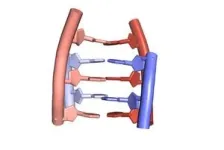(Press-News.org) London, UK: Heart experts say that everyone should have their levels of lipoprotein (a) (Lp(a) measured routinely at least once in life, following research from one of the most populous EU countries, Poland, that shows how common high levels of Lp(a) are in the general population.
The findings come from several studies presented at the European Society of Cardiology (ESC) Congress taking place in London, UK, this week [1] and published in two journals: Progress in Cardiovascular Disease and Archives of Medical Sciences [2].
LP(a) is a parcel of fats (also known as lipids) and a protein (known as apolipoprotein(a)) that carries the fats around the body. Lp(a) is very sticky and high levels have been shown to lead to faster furring of the coronary arteries and may also participate in the development of blood clots. These can cause heart attacks, stroke, heart disease and other cardiovascular diseases. Lp(a) levels are determined by people’s genes, and sometimes by conditions such as kidney disease or underactive thyroid glands. People with premature myocardial infarction (heart attack) and familial hypercholesteremia (FH), an inherited condition that causes extremely high cholesterol levels, will have their Lp(a) levels measured more often, but this is not common for the rest of the population.
It is estimated that around 1.5 billion people worldwide have elevated Lp(a) levels, higher than 50 milligrams per one-tenth of a litre (mg/dL) of blood, but accurate estimates for most European countries are still lacking. In addition, little is known about factors and conditions that could increase the risk of high Lp(a), what drugs could interfere with it, its role in complications during pregnancy, and whether low Lp(a) levels might increase the risk of diabetes.
Now, results from studies of three groups of Polish patients show for the first time that Lp(a) levels were found in between 20-34% of people either receiving preventive care or being treated for diseases of the heart and blood vessels (cardiovascular disease, CVD). They also demonstrate that the prevalence depends on the patients’ initial risk for cardiovascular disease.
Maciej Banach, Professor of Cardiology at the Medical University of Lodz, Poland, told the ESC Congress: “These results show that Lp(a) is highly prevalent in Poland, which is the eighth most populous country in the EU. They suggest that Lp(a) should be measured more routinely than happens at present, because as many as six million adults may have high Lp(a) out of a population of approximately 38.5 million.
“This is especially important in Europe, particularly in Central and Eastern European countries, where people tend to have a high risk of cardiovascular diseases, even before any symptoms or events occur. This is due to unhealthy lifestyles that include smoking, lack of exercise, overweight and obesity, and the consumption of alcohol and junk food.”
In the first study, Prof. Banach and colleagues analysed data from 511 patients (53% were women) at the Polish Mother’s Memorial Hospital Research Institute – the PMMHRI-Lp(a) study. This registry was established in 2022, and the researchers aimed to understand patients’ characteristics, prevalence of high Lp(a) levels and its association with other CVD risk factors in people with a high or very high CVD risk who attended departments or clinics for cardiology, endocrinology, congenital heart diseases, diabetes and metabolic diseases.
“We found Lp(a) levels of 30 mg/dL or higher in 20% of patients, and levels of 50 mg/dL in 28% of patients. We noticed significant differences in elevated Lp(a) levels in patients with familial hypercholesterolaemia, and after heart attack and with thyroid diseases. These are groups in which we should be especially careful to measure Lp(a) levels. We did not see any differences in Lp(a) by sex or age. PCSK9 inhibitors were the only therapies associated with a significant reduction in Lp(a) levels of about 45%,” said Prof. Banach.
In the second study, the STAR-Lp(a) study – led by Associate Professor Michal Chudzik, of the Centre of Postgraduate Medical Education in Warsaw and Medical University of Lodz, Poland, the researchers analysed data from 553 patients (66% were women) with risk factors for CVD but who did not have established CVD. They underwent coronary computed tomographic angiography (CTA). The aim was to use the coronary artery calcium (CAC) score to assess the relationship between elevated Lp(a) levels and the risk of developing narrowed arteries (atherosclerosis).
Prof. Banach said: “We found that the prevalence of Lp(a) levels ranged from 21.5% for Lp(a) of 30 mg/dL or more, to 13.5% for Lp(a) of 50 mg/dL or more. A prevalence of 21.5% means that about six million adult Poles have elevated Lp(a).
“We also confirmed a direct link between Lp(a) and atherosclerosis progression; for every 10 mg/dL increase in Lp(a), the CAC score increases by 16 points. What is more, in those with Lp(a) of 50 mg/dl or less, the chance of having a CAC Score of 0, meaning there was no sign of coronary artery disease, was 2.3 times higher than in those with elevated levels of Lp(a).
“These results confirm that if elevated Lp(a) levels are found in a patient, a CT scan of the coronary arteries with assessment of the CAC score should be considered to understand the level of risk of CVD.”
In the third study, presented to the Congress by Associate Professor Krzysztof Dyrbuś, from the Silesian Center for Heart Diseases at the Medical University of Silesia, Katowice, Poland, the researchers analysed data from the Zabrze-Lip(a)R Registry of 2001 patients with very high and extremely high risk of CVD. They wanted to understand the characteristics of patients at risk of atherosclerotic cardiovascular disease (ASCVD) and whether increasing levels of Lp(a) might cause faster furring of the arteries.
They found that 27% (540 patients) with established ASCVD had Lp(a) levels above 30 mg/dL; the prevalence of higher Lp(a) levels was very high in patients with chronic coronary syndrome (32%), in patients who had undergone percutaneous coronary intervention (32%) and in patients who had a previous heart attack (34%).
Prof. Banach said: “In addition, following diagnosis of acute coronary syndrome, elevated Lp(a) levels were found in 25% of patients, which could mean about 20,000 patients a year in Poland are affected by raised Lp(a). Among patients who have had a heart attack, we found elevated Lp(a) levels in 34%. In Poland there are about one million people who have had a heart attack, which means 340,000 may have elevated Lp(a), and this adds to an increased risk of another heart attack or other CVD problem.”
Assoc. Prof. Dyrbuś added: “These results show that 27% of patients who are at very high risk and have ASCVD experience an additional risk relating to an elevated Lp(a) level. Every second patient in this group had chronic coronary syndrome. Interestingly, one of the factors significantly related to elevated Lp(a) levels was a higher platelet count. This raises the question as to whether these patients should be treated with aspirin, something that is not currently recommended. More research needs to be carried out into this.”
(ends)
Notes:
[1] ESC Congress 2024 abstracts. Moderated e-posters:
ABSTRACT NO: 84947. The prevalence, patients characteristics and risk factors of hyper-Lp(a)-emia in the Polish population. The first results from the PMMHRI-Lp(a) Registry. Presenter: Maciej Banach (Medical University of Lodz - Lodz, Poland)
ABSTRACT NO: 84754. Lipoprotein(a) as a predictive marker of coronary artery calcification (CAC). The results from the STAR-Lp(a) cohort study. Presenter: Maciej Banach (Medical University of Lodz - Lodz, Poland)
ABSTRACT NO: 83965. Study of lipoprotein(a) and its impact on atherosclerotic cardiovascular disease: design, rationale, and first results of the Zabrze-Lip(a)R Registry. Presenter: Krzysztof Dyrbuś (Silesian Center for Heart Diseases (SCHD) - Zabrze, Poland).
NB: some of the data have been updated from the abstracts, which were submitted at the beginning of 2024. Use the data from this release and/or the journal papers in preference to the abstracts.
[2] Journal papers:
I) Sosnowska B, Lewek J, Adach W, Mierczak K, Bielecka-Dąbrowa A, Szosland K, Zygmunt A, Dąbrowski J, Banach M. The Prevalence, Patients’ Characteristics, and Hyper-Lp(a)-emia Risk Factors in the Polish Population. The First Results from the PMMHRI-Lp(a) Registry. Prog Cardiovasc Dis 2024.
II) Dyrbuś K, Mędrala Z, Konsek K, Nowowiejska-Wiewióra A, Trzeciak P, Skrzypek M, Cieśla D, Banach M, Gąsior M. Lipoprotein(a) and its impact on cardiovascular disease – the Polish perspective: design and first results of the Zabrze-Lipoprotein(a) Registry. Archives of Medical Science. 2024.
END
Experts call for routine measurement of lipoprotein (a) levels
Studies highlight the role played by Lp (a) in heart and blood vessel diseases
2024-08-29
ELSE PRESS RELEASES FROM THIS DATE:
Land-sea “tag-team” devastated ocean life millions of years ago reveal scientists
2024-08-29
Scientists have revealed how a “tag-team” between the oceans and continents millions of years ago devastated marine life – and altered the course of evolution on Earth.
Their study has unearthed a new explanation for a string of severe environmental crises, called oceanic anoxic events, which happened between 185 and 85 million years ago.
These occurred when the seas became critically depleted of dissolved oxygen.
Experts from the University of Southampton, which led the study, said these events triggered significant biological upheavals, including ...
Researchers map 50,000 of DNA’s mysterious ‘knots’ in the human genome
2024-08-29
Researchers map 50,000 of DNA’s mysterious ‘knots’ in the human genome
Innovative study of DNA’s hidden structures may open up new approaches for treatment and diagnosis of diseases, including cancer.
DNA is well-known for its double helix shape. But the human genome also contains more than 50,000 unusual ‘knot’-like DNA structures called i-motifs, researchers at the Garvan Institute of Medical Research have discovered.
Published today in The EMBO Journal is the first comprehensive map of these unique DNA structures, shedding light on their potential roles in gene regulation involved in disease.
In a landmark 2018 study, Garvan scientists ...
Can fungi turn food waste into the next culinary sensation?
2024-08-29
Chef-turned-chemist Vayu Hill-Maini has a passion: to turn food waste into culinary treats using fungi.
One of his collaborators is Rasmus Munk, head chef and co-owner of the Michelin two-star restaurant Alchemist in Copenhagen, who serves a dessert — orange-colored Neurospora mold grown on rice — inspired by Hill-Maini.
For the past two years, Hill-Maini has worked with a team of chefs at Blue Hill at Stone Barns, a Michelin two-star restaurant in Pocantico Hills, New York, to generate tasty morsels from Neurospora mold grown on grains and pulses, including the pulp left over from making oat ...
Women with endometriosis at greater associated risk of heart attack and stroke
2024-08-29
London, United Kingdom – 29 Aug 2024: According to research presented at ESC Congress 2024,1 women with endometriosis have a 20% greater risk of significant cardiac outcomes compared with women without endometriosis.
“For decades, cardiovascular disease (CVD) has been thought of as a man’s disease and risk factors have been considered from the male perspective, for example, including erectile dysfunction in guidelines on CVD risk assessment.2 Yet, 1 in 3 women die from CVD and 1 in 10 women suffer from ...
Catching up on sleep on weekends may lower heart disease risk by up to 20%
2024-08-29
London, United Kingdom – 29 August 2024: The demands of the working week, often influenced by school or work schedules, can lead to sleep disruption and deprivation. However, new research presented at ESC Congress 2024 shows that people that ‘catch up’ on their sleep by sleeping in at weekends may see their risk of heart disease fall by one-fifth.
“Sufficient compensatory sleep is linked to a lower risk of heart disease,” said study co-author Mr Yanjun Song of the State Key Laboratory ...
Quitting smoking nearly halves heart attack risk, cutting down does little
2024-08-29
London, United Kingdom – 29 August 2024: According to research presented today at ESC Congress 2024,1 patients with stable coronary artery disease who quit smoking at any timepoint after their diagnosis reduced their risk of a major event by almost 50%. In contrast, there was minimal impact on cardiovascular risk in patients who reduced their smoking habits.
The international CLARIFY registry (prospeCtive observational LongitudinAl RegIstry oF patients with stable coronary arterY ...
Children contribute to group projects when there are clear and common goals
2024-08-29
Children can work together to reach a target that benefits a whole group even if it is at a personal cost to themselves, a new study has shown.
Researchers invited groups of six to 10-year-olds to take part in a game where they were each given containers of water and could decide how much of it to offer into a common pool.
If the group contributed a certain amount of water it resulted in benefits for the whole group, but children also obtained benefits for any water they kept.
At the same time, the ...
Dine on DNA: Compounds from nucleic acids in food show anticancer effects
2024-08-29
When people eat, they ingest the nucleic acids that reside in all living things. The compounds in these acids could inhibit the growth of cancer cells, according to findings published in PLOS ONE by Osaka Metropolitan University Associate Professor Akiko Kojima-Yuasa of the Graduate School of Human Life and Ecology and colleagues.
Consuming nucleic acids found in food has been shown to boost the immune system and prevent some diseases. The nucleotides and nucleosides that result from digesting the acids are largely responsible for these beneficial effects.
Professor ...
MCG scientists working to understand why men with prostate cancer are at higher risk of Alzheimer’s
2024-08-29
AUGUSTA, Ga. (Aug. 29, 2024) – Researchers at the Medical College of Georgia at Augusta University are searching for a better way to understand why many men with prostate cancer end up with Alzheimer’s disease, and whether it’s the standard hormone therapy treatment or an overactive immune response that actually contributes to the problem.
The hormone therapy, androgen deprivation therapy, known as ADT, treats the cancer by reducing testosterone, which the cancer needs to grow. But androgen is a key regulator of amyloid metabolism and when it’s removed from the equation, more amyloid is left to form the plaques that are a hallmark of Alzheimer’s.
“We ...
Ancient sea cow attacked by a crocodile and sharks sheds new light on prehistoric food chains
2024-08-29
A new study describing how a prehistoric sea cow was preyed upon by not one, but two different carnivores – a crocodilian and a shark – is revealing clues into both the predation patterns of ancient creatures and the wider food chain millions of years ago.
Published in the peer-reviewed Journal of Vertebrate Paleontology, the findings mark one of the few examples of a creature being preyed upon by different animals during the Early to Middle Miocene epoch (23 million to 11.6 million years ago).
Predation marks in the skull indicate that the dugongine sea cow, ...
LAST 30 PRESS RELEASES:
How does age affect recovery from spinal cord injury?
Novel AI tool offers prognosis for patients with head and neck cancer
Fathers’ microplastic exposure tied to their children’s metabolic problems
Research validates laboratory model for studying high-grade serous ovarian cancer
SIR 2026 delivers transformative breakthroughs in minimally invasive medicine to improve patient care
Stem Cell Reports most downloaded papers of 2025 highlight the breadth and impact of stem cell research
Oxford-led study estimates NHS spends around 3% of its primary and secondary care budget on the health impacts of heat and cold in England
A researcher’s long quest leads to a smart composite breakthrough
Urban wild bees act as “microbial sensors” of city health.
New study finds where you live affects recovery after a hip fracture
Forecasting the impact of fully automated vehicle adoption on US road traffic injuries
Alcohol-related hospitalizations from 2016 to 2022
Semaglutide and hospitalizations in patients with obesity and established cardiovascular disease
Researchers ‘listen in’ to embryo-mother interactions during implantation using a culture system replicating the womb lining
How changing your diet could help save the world
How to make AI truly scalable and reliable for real-time traffic assignment?
Beyond fragmented markets: A new framework for efficient and stable ride-pooling
Can shape priors make road perception more reliable for autonomous driving?
AI tracks nearly 100 years of aging research, revealing key trends and gaps
Innovative techniques enable Italy’s first imaging of individual trapped atoms
KIER successfully develops Korea-made “calibration thermoelectric module” for measuring thermoelectric device performance
Diversifying US Midwest farming for stability and resilience
Emphasizing immigrants’ deservingness shifts attitudes
Japanese eels, climate change, and river temperature
Pusan National University researchers discover faster, smarter heat treatment for lightweight magnesium metals
China’s 2024 Gastroenterology Report: marked progress in endoscopy quality and disease management
Pusan National University researchers uncover scalable method for ultrahigh-resolution quantum dot displays
Researchers use robotics to find potential new antibiotic among hundreds of metal complexes
Gut bacteria changes at the earliest stages of inflammatory bowel disease
Scientists develop new way to “listen in” on the brain’s hidden language
[Press-News.org] Experts call for routine measurement of lipoprotein (a) levelsStudies highlight the role played by Lp (a) in heart and blood vessel diseases







